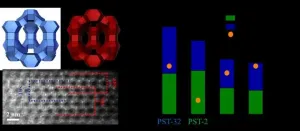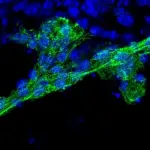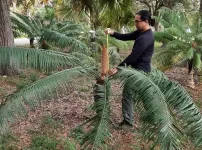The twinkle and the brain
Scientists at the IST Austria rejuvenate mouse brains with ketamine or flickering light
2021-07-06
(Press-News.org) Can you remember the smell of flowers in your grandmother's garden or the tune your grandpa always used to whistle? Some childhood memories are seemingly engrained into your brain. In fact, there are critical periods in which the brain learns and saves profound cognitive routines and memories. The structure responsible for saving them is called the perineuronal net.
This extracellular structure envelops certain neurons, thereby stabilizes existing connections - the synapses - between them and prevents new ones from forming. But what if we could remove the perineuronal net and restore the adaptability of a young brain? The neuroscientist Sandra Siegert and her research group at IST Austria now published two promising techniques to do so.
Taking Ketamine or Flashing Lights
It all began four years ago when the researchers at IST Austria found that microglia cells in mice become very reactive after they had anesthetized animals with the drug ketamine. Microglia are typically seen as the brain's immune cells. However, recent studies have shown that they also interact with the neurons. The reactive microglia have the ability to eat synapses and even entire neurons, which is often seen in the late phases of Alzheimer's disease.
"The strong response of the microglia upon ketamine anesthesia surprised us," explains Alessandro Venturino, leading author in the study and member of the Siegert group. "But we did not see any synapses or dead neurons vanishing. So, we were puzzled, what the microglia were actually eating." It turned out to be the perineuronal net that protects and stabilizes the connections between neurons.
"Alessandro came to my office and told me that the perineuronal net was gone. I could not believe it," Siegert remembers. They had applied repeated anesthetic dosages of ketamine to mice. Ketamine is an essential drug for human surgery and was also recently approved for treating psychiatric symptoms. "After just three treatments, we could see a considerable loss in the perineuronal net, which lasted for seven days before being rebuilt."
When Siegert shared the results with Mark Bear, collaborating neuroscientist at the Massachusetts Institute of Technology (MIT), he was equally amazed and intrigued by the potential of this discovery. "In biology, you rarely witness such a black-and-white situation," Siegert continues. "Yet, the cherry on top was the effect of the 60-hertz light flickering."
Neurons communicate by sending electric impulses to each other. These are coordinated to create waves of signals - so-called brainwaves - which can be influenced by external sensory information, for example, light shining into the eyes. "It had been previously shown that light flickering 40 times a second - at 40 hertz - can promote microglia to remove plaques in Alzheimer disease. But it did not remove the perineuronal net," Venturino explains. But when the scientists then put mice in boxes with light flickering 60 times a second, it had a similar effect as the ketamine treatments. "This fine-tuning between distinct brainwaves and the microglia action is the most fascinating and might be a new way of thinking about brainwaves."
Caution and Possibilities
Previously established strategies to remove the perineuronal net are long-lasting and extremely invasive. The high-dosage ketamine treatment but even more so the 60-hertz light flickering are minimally invasive. Therefore, they could open new therapeutic approaches in humans.
Once the blocking of the perineuronal net in the brain is lessened, neurons are again sensitive to new input, and new synapses can be formed. "But it is not like you take ketamine as a drug and become smart", Venturino emphasizes. By re-establishing plasticity, one could potentially overwrite traumatic experiences and treat post-traumatic stress disorder. "But we are very cautious because in this formative window also something traumatic could happen," Siegert says. "It is probably also not a good idea to blast yourself with flickering light."
There are various possible applications for these treatments, one being amblyopia, also known as the lazy eye. This sight disorder is caused by an unbalanced visual input during a child's development and, if untreated, leads to permanent loss of vision. Another topic the researchers want to investigate is the molecular mechanisms behind their discovery which are still not fully understood. Venturino puts it in a nutshell: "There is a lot to explore."
INFORMATION:
ELSE PRESS RELEASES FROM THIS DATE:
2021-07-06
Dinosaurs were generally huge, but a new study of the unusual alvarezsaurs show that they reduced in size about 100 million years ago when they became specialised ant-eaters.
The new work is led by Zichuan Qin, a PhD student at the University of Bristol and Institute of Vertebrate Paleontology and Paleoanthropology in Beijing. He measured body sizes of dozens of specimens and showed that they ranged in size from 10-70 kg, the size of a large turkey to a small ostrich, for most of their existence and then plummeted rapidly to chicken-sized animals at the same time as they adopted a remarkable ...
2021-07-06
An international team of scientists has used high-powered X-rays at the European Synchrotron, the ESRF, to show how an extinct South African 200-million-year-old dinosaur, Heterodontosaurus tucki, breathed. The study is published in eLife on 6 July 2021.
In 2016, scientists from the Evolutionary Studies Institute at the University of the Witwatersrand in Johannesburg, South Africa, came to the ESRF, the European Synchrotron in Grenoble, France, the brightest synchrotron light source, for an exceptional study: to scan the complete skeleton of a small, 200-million-year-old plant-eating dinosaur. The dinosaur specimen is the most complete fossil ever discovered of a species known as Heterodontosaurus tucki. The fossil was found in ...
2021-07-06
At the end of life, people may have to rely on others for help with showering, dressing and going to the toilet. This loss of privacy and independence can be confronting and difficult.
Now Australian occupational therapy (OT) researchers have interviewed 18 people receiving palliative care about how they feel about losing independence with self-care, specifically their intimate hygiene, as function declines with disease progression.
The study aims to raise awareness of how to provide better care for people at the end of life.
Lead researcher Dr Deidre Morgan, a Flinders University occupational ...
2021-07-06
A research team at POSTECH has uncovered a promising new zeolite, anticipated to be a turning point for the oil refining and petrochemical industries. This research was recently published in the scientific journal Science on July 2, 2021.
The team of researchers led by Suk Bong Hong, a professor in the Division of Environmental Science and Engineering at POSTECH, synthesized two thermally stable three-dimensional (3D) large-pore (12-ring)1 zeolites - PST-32 (POSTECH No. 32) and PST-2, the hypothetical SBS/SBT intergrowth structure2 - by using the "multiple inorganic cation" and the "charge density mismatch" synthetic strategies, respectively. The research team identified their structures by using both powder X-ray diffraction ...
2021-07-06
New research in BMC Cancer has shown myelosuppressive chemotherapy destabilises gut microbiome in patients with solid organ cancers.
The study from SAHMRI and Flinders University assessed the gut health of men and women who underwent conventional chemotherapy on cancers, such as breast and lung cancer, without exposure to antibiotics.
"We know that myelosuppressive chemotherapy reduces white blood cell count significantly during the first seven to 10 days of treatment, making the body more vulnerable to infection," says lead author Dr Lito Papanicolas, an infectious diseases expert and clinical microbiologist.
"In this study we focused on how much the individual's microbiome changed over this period, when the ...
2021-07-06
Scientists at UC San Francisco have shown that gene-edited cellular therapeutics can be used to successfully treat cardiovascular and pulmonary diseases, potentially paving the way for developing less expensive cellular therapies to treat diseases for which there are currently few viable options.
The study, in mice, is the first in the emerging field of regenerative cell therapy to show that products from specially engineered induced pluripotent stem cells called "HIP" cells can successfully be employed to treat major diseases while evading the ...
2021-07-06
A 15-year reciprocal transplant study on Guam's native cycad tree, Cycas micronesica, by the Plant Physiology Laboratory at the University of Guam's Western Pacific Tropical Research Center has revealed that acute adaptation to local soil conditions occurs among the tree population and is important in the survival rate of transplanted cycads. The results show that 70% to 100% of cycads that were transplanted in local conditions survived versus less than 10% that were transplanted in foreign conditions. The article describing the study has been published in the peer-reviewed journal Diversity (doi: 10.3390/d13060237).
Transplantation ...
2021-07-06
Vertical greenery 'planted' on the exterior of buildings may help to buffer people against stress, a Nanyang Technological University, Singapore (NTU Singapore) study has found.
The benefits of nature on mental health and for wellbeing have long been recognised, and now a team of NTU Singapore psychologists has used Virtual Reality (VR) to examine whether vertical greenery has a stress buffering effect (ability to moderate the detrimental consequences of stress) in an urban environment.
Using VR headsets, 111 participants were asked to walk down a virtual street for five minutes. Participants were randomly assigned to either a street that featured rows of planted greenery (e.g., on balconies, walls, and pillars of buildings), ...
2021-07-06
Attention training in young people with autism can lead to significant improvements in academic performance, according to a new study.
Researchers at the University of Birmingham in the UK along with institutions in São Paolo, in Brazil, tested a computer programme designed to train basic attention skills among a group of autistic children aged between eight and 14 years old.
They found participants achieved improvements in maths, reading, writing and overall attention both immediately after undergoing the training and at a three-month follow up assessment. Their results are published in Autism Research.
Lead researcher, Dr Carmel Mevorach, in the University of Birmingham's Centre for Human Brain Health, and School of Psychology, says: "It's ...
2021-07-06
The urgency to remember a dangerous experience requires the brain to make a series of potentially dangerous moves: Neurons and other brain cells snap open their DNA in numerous locations--more than previously realized, according to a new study--to provide quick access to genetic instructions for the mechanisms of memory storage.
The extent of these DNA double-strand breaks (DSBs) in multiple key brain regions is surprising and concerning, said study senior author Li-Huei Tsai, Picower Professor of Neuroscience at MIT and director of The Picower Institute for Learning and Memory, because while the breaks are routinely repaired, that process may become more flawed and fragile with age. Tsai's lab has shown that lingering DSBs are associated with neurodegeneration ...
LAST 30 PRESS RELEASES:
[Press-News.org] The twinkle and the brain
Scientists at the IST Austria rejuvenate mouse brains with ketamine or flickering light







